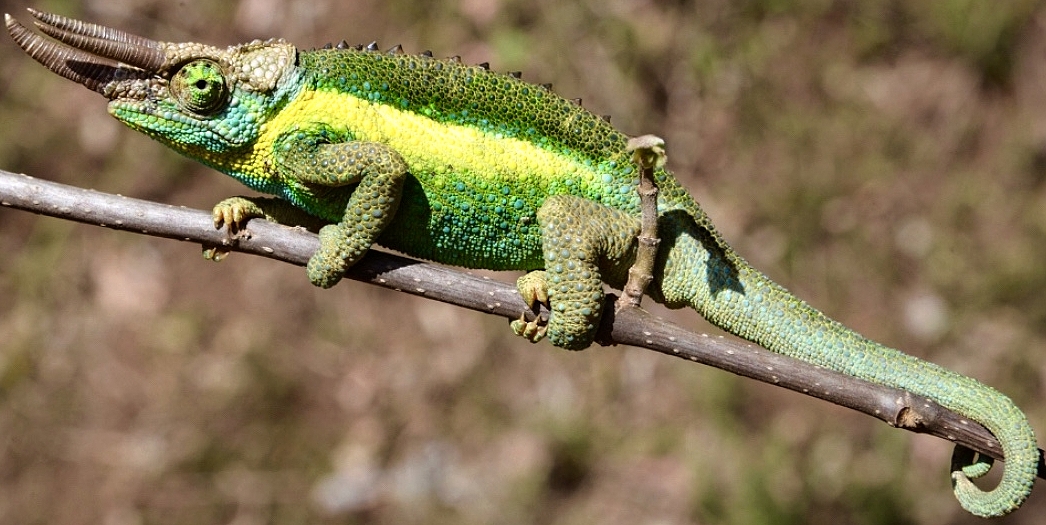Trioceros jacksonii
Jackson's Three-Horned Chameleon
Author: Petr Nečas
Climate Reference Locality Weather Forecast
Download files
Profile
Origin: Kenya (Central Highlands), USA (introduced to Hawaii)
Average total length: Males 12in (30cm), Females 8in (20cm)
Longevity in captivity: Up to 8 years, Average 3-4 years
Longevity in the wild: Up to 4 years
Temperature at daytime: Low 70s F (21-23°C)
Temperature basking spot: Low 80s F (26-28°C)
Temperature at night: Maximum Low 60s F (15-17°C), Ideally 50s F (below 15°C)
Humidity at daytime: Below 60%
Humidity at night: 100%, fog
Food: Insects only, No vegetables, No fruits
Indoor Housing
Size: The bigger, the better, minimum 24x18x36in (60x45x90cm)
Cage type: Full mesh or hybrid (combination of mesh and glass or panel)
Lights: UVB source (inside or outside), Daylight source (Window or LED) (inside or outside), Heat source (outside)
Hydration: Fogger at night, Hand misting morning and evening
Ventilation: Full mesh, Small fans when using a hybrid cage and/or air is stagnant
Interior: Live plants (no fake), natural branches (no fake vines, no ropes, no bleached wood), no substrate
Care
UVB light source: T5 HO 12 hours a day, 5-12% according to cage height
Visible light: Full spectrum or natural light, 12 hours per day
Basking spot: Low 80s F (26-28°C), 1 hour max 2 times a day
Temperature at daytime: Mid 70s F (21-23°C)
Temperature at night: Max. Low 60s F (15-17°C), Ideally 50s F (below 15°C)
Humidity at daytime: 50-70%
Humidity at night: 100%, Fog
Hydration: Fogger at night, Hand misting, Dripper
Food type: Crickets, Soldier Flies, Roaches, No vegetables, No fruits
Food volume: Juveniles no limit, Adults max 1 cricket daily
Supplementation - Each meal: Plain Calcium, Bee Pollen
Supplementation - Once in two weeks: Calcium with D3
Sex Determination
In the Yellow-Created Jackson's Chameleons, the sexes differ in many features from each other. They show the s.c. Primary sexual dimorphism, which is expressed through the presence of sexual glands (testes with ductus deferens in males and ovaries with oviducts in females) and copulatory organs (hemipenes in males, hemiclitoris in females).
The problem for sexing animals is, that some of these organs (first group) are situated in the body cavity and some (the second group) in special pockets at the base if the tail, none of them are invisible from outside.
There is a technique how to evert the hemipenis, but in young animals and in animals which are dehydrated, old or out of breeding season, it does not work reliably, plus, it might be painful for the animal and is definitely rather stressful, especially if done by an inexperienced owner, therefore not recommended.
Fortunately, there are several Secondary sexual characteristics, which allow us to define the sex rather reliably, especially in adult animals:
CRANIAL HORNS
The male possess three big true rostral horns up to over 2in long, directed forwards while the females remain hornless. On the analogous places, where in males horns grow from the canthi rostrales, pointed tiny conical scales might be present in females. Extremely rarely, also one-horned females occur (2 in history).
SIZE
The males are much bigger than the females, they can reach up to 17in / 12in resp, usually stay much smaller
BODY PROPORTIONS
The females are built more compact with smaller heads
TAIL BASE
Due to the presence of male copulatory organs, hemipenes, the tail base behind cloacal is thicker/swollen in males
DORSAL CREST
The conical scales on the dorsal crest are relatively much bigger in males and are usually of yellow color, while in females the are
Smaller and resemble usually in color the surrounding skin
COLORATION
The excited males are usually of green to yellow color on the body, with dark green to dark blue casque and cheeks and light blue tail base while females are colored usually more conspicuously, either with a pattern or uniformly reddish brown, or grey or green. Females colored similar like excited males are known from Hawaii.
For reliable sex determination, rhe horns are a good guidance in all ages, even fresh born males have already tiny horns.
NOTE
There are more forms and
subspecies of this chameleon species, the most features determining sex fit,
but there is a variability in coloration and in the number and level of
development of cranial horns in the females: they can have one or three horns
of various size, while males have always three.
TABLE
The left column relates always to male, the right to females It
shows the differences (top down) in:
General habitus
Head form and horns
Tail base
Dorsal crest

